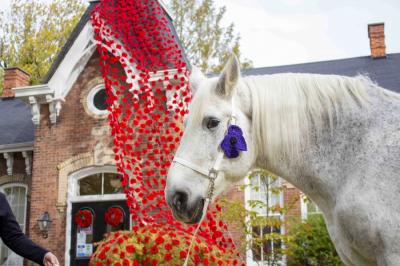The sufferings of war are not reserved for man alone. It is estimated that eight million horses died in active service during the First World War and the purple poppy is growing as a symbol of animal sacrifice in the service of man’s most violent indulgence.
Cinderella, a 16-year-old percheron carriage horse with Sentineal Carriages, wore a purple poppy in front of the Niagara-on-the-Lake Museum’s poppy display to honour the millions of horses and service animals killed during the two world wars.
The purple poppy is commonly used in the United Kingdom to honour the animal victims of the First and Second World Wars, said Barbara Worthy, members assistant with the museum.
“They were introduced in Britain. The idea was to honour and commemorate the use of horses and other animals in the war years,” she said.
“For soldiers, their animals who fought in the war were like other soldiers. They were like their comrades.”
Cinderella is a massive Percheron standing nearly two-metres high at the shoulder and weighing almost 1,800 pounds, her handler said. Her powerful build made it clear why the horse had long been man’s best friend in times of war.
The purple poppy is being promoted by the Animal Alliance of Canada as a way to acknowledge the millions of animals that have died in human wars.
But the alliance stresses that this does not put the animals on equal footing as the many soldiers who chose to fight.
“It is tempting to anthropomorphize (animals’) actions as acts of bravery or courage, but they had no choice in being there and had no comprehension of what they were being used for,” the alliance’s website says.
The purple poppy “is not meant in any way to undermine or reject the red poppy and its symbolism of the human lives who served and died in war.”
While crocheting some 3,500 red poppies for the museum’s display, volunteers also made several purple poppies and decided to give those to the many carriage horses that call Niagara-on-the-Lake home. The horses can be seen with their purple accoutrements working their shifts in Old Town.
And while horses may not volunteer for military service, the outstanding examples of some animals-of-war are celebrated by the military.
Sergeant Reckless was a munitions-carrying Mongolian racehorse for the United States Marines during the Korean War. Reckless was a heavily decorated horse, receiving two Purple Hearts and the Dickin Medal, commonly referred to as the Victoria Cross for animals, among others.
“She would be my hero if I was a horse,” said Cinderella’s handler Cece.
During the Battle for Outpost Vegas in Korea in March1952, Reckless made 51 solo trips carrying 10,000 pounds of ammunition to the front line, returning with wounded soldiers on her back. Reckless covered more than 35 miles that day and became a horse hero, according to the book, “Reckless: Pride of the Marines,” by Andrew Geer.
Reckless was named one of the top 100 American heroes of all time by Life Magazine in 1997.
“It’s magnificent to remember the use and what (animals) suffered,” Worthy said.
She agreed that the animals’ innocence in war does not give them the same distinctions as young men and women who sign up to enter military service.
But “It’s their innocence that makes my heart burst,” she said.











